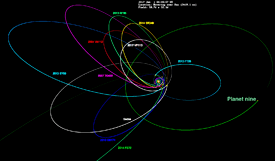2013 SY99
 The orbits of 2013 SY99 (left; light blue) and other detached objects, along with the hypothetical Planet Nine's orbit (right; green) | |
| Discovery [1] | |
|---|---|
| Discovered by | OSSOS |
| Discovery site | CFHT |
| Discovery date | 29 September 2013 |
| Designations | |
| MPC designation | 2013 SY99 |
| uo3L91 | |
| TNO · detached | |
| Orbital characteristics | |
|
Epoch 23 March 2018 (JD 2458000.5) | |
| Uncertainty parameter 4[2] | |
| Observation arc | 3.16 yr[2] |
| Earliest precovery date | 5 September 2013 |
| Aphelion |
|
| Perihelion |
49.97 ± 0.06 AU[2] (7.48 ± 0.01 billion km; 4.65 ± 0.01 billion mi) |
| Eccentricity | 0.926±0.002[2] |
| 359.240°±0.036°[2] | |
| 0.203±0.010 arcsec/day[2] | |
| Inclination | 4.233°±0.001°[2] |
| 29.478°±0.005°[2] | |
| 32.245°±0.112°[2] | |
| Jupiter MOID |
44.94 AU[2] (6.7 billion km; 4.2 billion mi) |
| Physical characteristics | |
| Dimensions | ≈250 km (160 mi)[5] |
| 0.05±0.03[5] | |
| moderately red[5] | |
|
24.5 (V)[6] 23.67 (peak 2055)[2] | |
|
6.7958±0.28664[6] 6.7[2] | |
|
| |
2013 SY99, also known as uo3L91, is a trans-Neptunian object discovered on September 29, 2013 by the Outer Solar System Origins Survey using the Canada–France–Hawaii Telescope at Mauna Kea Observatory. This object orbits the Sun between 50 and 1,300 AU (7.5 and 190 billion km), and has a barycentric orbital period of nearly 20,000 years.[3][4][1] It has the largest semi-major axis yet detected for an orbit with a perihelion beyond the zone of strong influence of Neptune (q > 38), exceeding the semi-major axes of Sedna, 2012 VP113 and 2010 GB174.[7][8] 2013 SY99 has one of highest perihelion of any known extreme trans-Neptunian object, behind sednoids including Sedna (76 AU), 2012 VP113 (80 AU), and 2015 TG387 (65 AU).
Discovery
According to astronomers Mike Brown and Konstantin Batygin, the discovery of 2013 SY99 provides additional evidence for the existence of Planet Nine, but Michele Bannister (see 10463), one of the astronomers who reported the discovery of this object, counters that it travels an orbit that is almost within the plane of the Solar System, rather than being tilted at high angles, as might be expected if it were being shepherded by a Planet Nine.[1][9]
Its existence was announced in 2016, but the observations were kept private until 2017. It was listed at the Minor Planet Center and the JPL Small-Body Database on 6 April 2017[6] with a three-year observation arc and an epoch 2017 heliocentric orbital period of 17,500 years.[2] Barycentric orbital solutions, however, are more stable for objects on multi-thousand year orbits, and the barycentric period for 2013 SY99 is 19,700 years.[3][n 1]
As of March 2018, its perihelion distance of q=49.97±0.06 AU and semi-major axis a=673±21 AU bring 2013 SY99 close to being a sednoid (q>50 AU, a>150 AU). However, 2013 SY99 is usually considered to be an extreme trans-Neptunian object and not a sednoid.[10] In the heliocentric reference frame, the perihelion is currently rising, and the nominal orbit will have a perihelion above 50 AU by October 2018.[11]
2013 SY99 is estimated to be about 250 km (160 mi) in diameter and moderately red in color.[5] In 2052 it will be roughly 20.3 AU (3.04 billion km) from Neptune. It will come to perihelion (closest approach to the Sun) around 2055 when it will be 50 AU (7.5 billion km) from the Sun.[2]
See also
Notes
- 1 2 3 4 Heliocentric solutions are unstable due to the changing position of Jupiter over Jupiter's 12 year orbit which perturbs the eccentricity of the two-body solution of the Sun+asteroid. Barycentric solutions are more stable for objects that take thousands of years to orbit the Sun. Between epoch 2017 and epoch 2029, the heliocentric orbital period varies from a low of 17400 years "PR= 6.364×106 d (epoch 2017-Nov-16)" to a high of 26100 years "PR= 9.538×106 d (epoch 2023-Nov-16)".
References
- 1 2 3 Witze, Alexandra (18 October 2016). "Astronomers spot distant world in Solar System's far reaches". Nature. doi:10.1038/nature.2016.20831.
- 1 2 3 4 5 6 7 8 9 10 11 12 13 14 15 16 17 "JPL Small-Body Database Browser: (2013 SY99)" (last observation: 4 November 2016; arc: 3.16 years). Jet Propulsion Laboratory. Retrieved 4 October 2018.
- 1 2 3 4 5 Horizons output. "Barycentric Osculating Orbital Elements for 2013 SY99". Retrieved 6 April 2017. (Ephemeris Type:Elements and Center:@0)
- 1 2 Mann, Adam (17 October 2016). "New icy world with 20,000-year orbit could point to Planet Nine". Science. doi:10.1126/science.aal0270.
- 1 2 3 4 Bannister, Michele; Shankman, Cory; Volk, Katherine (2017). "OSSOS: V. Diffusion in the orbit of a high-perihelion distant Solar System object". arXiv:1704.01952. Bibcode:2017AJ....153..262B. doi:10.3847/1538-3881/aa6db5.
- 1 2 3 "MPEC 2017-G55 : 2013 SY99". IAU Minor Planet Center. 6 April 2017. Retrieved 6 April 2017. (K13S99Y)
- ↑ "Objects with q > 38 & a > 250". Minor Planet Center. International Astronomical Union. Retrieved 24 October 2016.
- ↑ Bannister, Michele T.; Chen, Ying-Tung; Jakubik, Marian; et al. (October 2016). A new high-perihelion a ~ 700 AU object in the distant Solar System. 48th Meeting of the Division for Planetary Sciences. 16–21 October 2016. Pasadena, California. Bibcode:2016DPS....4811308B. 113.08.
- ↑ Brown, Mike (24 March 2016). "the new one is uo3L91..." Twitter.com.
- ↑ Scott Sheppard; Chadwick Trujillo; David Tholen; Nathan Kaib (2 October 2018). "A New High Perihelion Inner Oort Cloud Object" (PDF). arXiv:1810.00013. Retrieved 4 October 2018.
- ↑ JPL Horizons On-Line Ephemeris System. "Ephemeris Type: ELEMENTS, Target Body: Asteroid (2013 SY99), Center: Sun (body center) [500@10], Time Span: Start=2018-10-01, Stop=2018-10-15, Step=1 d, Table Settings: defaults, Display/Output: default (formatted HTML)". Retrieved 4 October 2018.
External links
- OSSOS survey by the Canada–France–Hawaii Telescope
- Exploring the outer Solar System: now in vivid colour on YouTube (18 March 2016); discovery of uo3L91 discussed at 28:13
- 2013 SY99 at the JPL Small-Body Database

